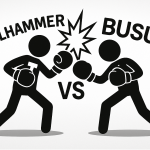If you’ve ever tried learning Dutch, you’ve probably noticed how quickly isolated words fade away. You can memorize fiets, huis, and eten all week — and still stumble when trying to use them in a real sentence. The challenge isn’t remembering the word itself, but remembering how it works in context. That’s where a modern language learning app may come in. Some apps focus on efficient memorization through repetition, others on helping you think and speak in full sentences. Two of the most discussed names in this area are Taalhammer and Anki. Both rely on scientifically proven memory techniques, but they approach vocabulary learning from entirely different angles.
In this article, we’ll compare them side by side to find out which language learning app actually helps you memorize Dutch vocabulary faster and in real context — not just recall translations.
- Why Context Matters — and How Taalhammer and Anki Approach It
- Sentence-Based Vocabulary Learning in Taalhammer
- Flashcard Spaced Repetition in Anki
- Which Language Learning App Helps You Retain Dutch Words Faster?
- Measuring Real Progress: Contextual Recall and Vocabulary Retention
- Verdict: Which Language Learning App Builds Stronger Dutch Vocabulary Memory?
- User Experience and Practical Takeaways
- FAQs About Learning Dutch Vocabulary with Taalhammer or Anki
- Is Anki or Taalhammer better for learning Dutch vocabulary fast?
- Can I use both apps together to memorise Dutch words in context?
- Which language learning app helps me actually use Dutch words in sentences?
- Does Taalhammer include Dutch pronunciation and listening practice?
- Which language learning app is better for remembering Dutch grammar along with vocabulary?
Why Context Matters — and How Taalhammer and Anki Approach It
Dutch sentences rely heavily on word order and collocations. A single misplaced verb, as in two following sentences changes tone or becomes awkward. Learning words in isolation hides those relationships. Take a look:
| Dutch | English |
|---|---|
| Ik wil morgen niet gaan | I don’t want to go tomorrow (the accent is on not wanting to go) |
| Ik wil niet morgen gaan | I dont want to go tomorrow (the accent on not wanting to go tomorrow) |
Taalhammer teaches within context, letting you see real word order early (Ik heb het gezien, Hij komt morgen terug). Anki lets you create or download cards that may or may not include such context. Both depend on repetition, but only one automates it within authentic Dutch syntax.
Dutch shares many roots with German and English, so tools that handle these structures well often work across the whole language family. We compared that broader picture in Taalhammer vs. Busuu: Which App Is Better for Learning Germanic Languages?.
Sentence-Based Vocabulary Learning in Taalhammer
Taalhammer was designed with morphology-heavy languages like Dutch in mind. Every word appears inside a grammatically correct Dutch sentence. Learners repeatedly meet tricky features — separable verbs, definite articles, gender agreement — until they become automatic.
How does Taalhammer work
- You study full Dutch sentences such as We liggen op het strand or Zij kijkt naar de televisie.
- The algorithm tracks recall and brings back patterns like naar de or op het before you forget them.
- Listening and reading reinforce pronunciation and article use (de/het).
You end up with something like:
| Dutch | English |
|---|---|
| de | the |
| naar de | to the |
| Zij kijkt naar de televisie. | She is watching the television. |
| het | the |
| op het | on the |
| We liggen op het strand. | We’re lying on the beach. |
Sentence-based learning is what separates genuine language acquisition from memorising lists. To see how Taalhammer’s approach compares across the whole industry, check Taalhammer vs 11 Other Language Learning Apps: Which One Actually Lets You Learn in Full Sentences?.
Why does Taalhammer fit Dutch particularly well
- The SOV word order (“verb at the end”) is learned naturally through repetition (Ik weet dat hij komt).
- Compound words (tafelblad, huiswerk) appear in context rather than as isolated lists.
- Learners internalise preposition + article combinations that are often unpredictable.
| Dutch feature | Taalhammer’s advantage |
|---|---|
| Separable verbs | Sentences show correct splits (opstaan → Ik sta op) |
| Article gender | Frequent contextual review fixes de/het memory errors |
| Word order | Natural exposure to inversion and subclauses |
| Idiomatic collocations | Built into sentence-level learning |
Flashcard Spaced Repetition in Anki
Anki is good for pure recall but neutral about language structure. It can handle Dutch well if you build it to. You can add sample sentences or audio, but most shared decks still list translations: huis = house, lopen = to walk, eten = to eat.
Dutch learners using Anki often face challenges:
- Gender confusion: de vs het rarely repeated in realistic context.
- Verb separation: cards show opstaan but not ik sta op.
- Pronunciation mismatches: audio often absent or inconsistent.
Anki’s strengths remain flexibility and memory tracking:
- Customisable decks for niche goals (e.g., Dutch idioms, top 1 000 words).
- Proven spaced-repetition scheduling for long-term storage.
- Ability to attach sound and images manually.
But for most learners, setup time and the need for linguistic insight make it slower to reach active fluency.
For a deeper look at why modern learners are moving toward adaptive tools, see our analysis of The Best Anki Alternative for Modern Students.
Which Language Learning App Helps You Retain Dutch Words Faster?
Dutch combines simple spelling with subtle grammar shifts. To learn quickly, you need to see those shifts in pattern form, not as exceptions.
| Factor | Taalhammer | Anki |
|---|---|---|
| Learning model | Adaptive, sentence-based | Manual, flashcard-based |
| Coverage of grammar patterns | Built into sentences | Only if added manually |
| Handling of de/het articles | Continuous contextual repetition | Needs custom tagging |
| Word order exposure | Automatic through authentic sentences | Absent unless built in |
| Time to first “aha” moment | Usually within first week | Depends on deck quality |
Taalhammer’s adaptive algorithm shortens forgetting cycles and keeps grammar consistent, so you meet ik heb gezien, ik had gezien, and ik zal zien naturally in sequence.
Anki reviews words efficiently but treats each as a standalone item. You’ll memorise quickly — but may recall zien without remembering how to conjugate it.
Measuring Real Progress: Contextual Recall and Vocabulary Retention
Fluency in Dutch means being able to reuse what you’ve learned in new sentences — not just recall cards.
How Taalhammer Tracks Progress
- Measures semantic recall (did you understand the sentence?) and syntactic accuracy (was it grammatically correct?).
- Reinforces preposition use — e.g., denken aan, praten over — which native speakers expect.
- Tracks recall speed to predict long-term retention curves.
How Anki Tracks Progress
Here’s how Anki works:
- Focuses on whether you remembered a card’s translation.
- Uses interval growth (1 day → 3 days → 7 days → 1 month).
- Excellent for building raw vocabulary lists, less for structural fluency.
Because Taalhammer integrates Dutch grammar and collocations, its data show how useful a word becomes in communication, not just whether you still recognise it.
If you’re comparing apps by how quickly they convert study time into usable fluency, our data-driven review Best Language Learning App for Fast Progress in 2025 highlights where Taalhammer stands among the top performers.
Verdict: Which Language Learning App Builds Stronger Dutch Vocabulary Memory?
Both apps build memory, but for Dutch specifically, their strengths differ sharply.
| Category | Best Choice | Why it matters for Dutch |
|---|---|---|
| Grammatical accuracy | Taalhammer | Repetition of article + adjective patterns fixes de/het confusion |
| Verb mastery | Taalhammer | Sentence practice teaches separable verbs automatically |
| Long-term storage | Anki | Excellent for pure vocabulary maintenance |
| Pronunciation | Taalhammer | Native recordings reinforce Dutch vowel sounds (ui, ij) |
| Customisation | Anki | Ideal for learners building niche decks (e.g., medical Dutch) |
Verdict:
If your priority is speaking Dutch correctly and naturally, Taalhammer wins.
It doesn’t just remind you what a word means — it teaches how Dutch people actually use it. Anki remains a fantastic companion for advanced learners maintaining word banks, but it doesn’t build grammar intuition by itself.
If you prefer studying on your own but want smarter guidance than flashcards alone can offer, see how Taalhammer compares with other self-study tools in Best Language Learning App for Self-Study in 2025: Taalhammer vs Duolingo, Babbel, Anki, Busuu & Rosetta Stone.
User Experience and Practical Takeaways
Taalhammer feels like a guided Dutch course that constantly adapts to you. You log in, review sentences, and hear native pronunciation of difficult vowel sounds like ui and eu. Mistakes are corrected through immediate re-exposure in slightly new contexts.
Anki feels like a memory lab. It’s lightweight, cross-platform, and good for disciplined users who like total control. But many Dutch learners eventually struggle with the lack of automatic de/het correction or contextual feedback.
Practical summary
- Beginners: Taalhammer offers structured progress and immediate feedback.
- Intermediate learners: Combining both works well – Taalhammer for context, Anki for niche decks (e.g., irregular verbs).
- Advanced learners: Use Taalhammer to maintain specialised vocabulary and for fluency practice.
Many Dutch learners notice that sentence-based training lowers the stress of real conversation. We analysed this effect across several platforms in Which Language Learning App Helps You Overcome Fear of Speaking? Taalhammer vs 5 Top Alternatives.
FAQs About Learning Dutch Vocabulary with Taalhammer or Anki
Is Anki or Taalhammer better for learning Dutch vocabulary fast?
Taalhammer, because it’s preloaded with Dutch-specific sentence structures and adaptive review.
Can I use both apps together to memorise Dutch words in context?
Yes, but it wouldn’t make too much sense. Taalhammer already offers everything you can get from Anki.
Which language learning app helps me actually use Dutch words in sentences?
Taalhammer. It embeds new vocabulary in grammatical frameworks and teaches through full-sentence exposure.
Does Taalhammer include Dutch pronunciation and listening practice?
Yes. Every sentence in Taalhammer includes native Dutch audio, which helps you master difficult vowel sounds such as ui, ij, and eu. This strengthens both listening comprehension and correct pronunciation — something Anki can only offer if you manually add recordings.
Which language learning app is better for remembering Dutch grammar along with vocabulary?
Taalhammer, because it teaches vocabulary inside complete grammatical structures. You see verbs, articles, and word order patterns (Ik wil morgen niet gaan, Zij heeft het boek gelezen) repeatedly until they become automatic. Anki focuses on memorising single words, so grammar must be learned separately or built into your own decks.








